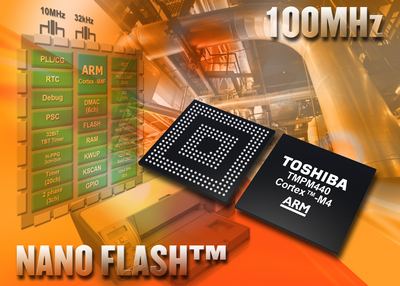High-speed micros with DSP extensions, FPU and parallel processing deliver ultra-low-power digital processing
Toshiba Electronics Europe has announced European availability of the company’s first ARM Cortex-M4 microcontrollers. The TMPM440 series meets the high-speed, ultra-low-power digital processing requirements of applications ranging from digital cameras, audio equipment and computer peripherals to communications systems, digital home appliances and sensor/detection systems.

The high-performance TMPM440 devices combine the ARM Cortex-M4 core operating at up to 100MHz with DSP extensions, a floating point unit (FPU) and a programmable servo/sequencer controller (PSC). This allows the device to perform parallel processing of key functions such as filtering and arithmetic to deliver optimum performance.
Toshiba’s new microcontrollers are available with 768KB or 1024KB of NANO FLASH-100 memory and 64KB of SRAM. Low-power, high-speed NANO FLASH memory supports industry-leading 100MHz zero wait state operation. This allows the core in ARM-based microcontrollers to fully utilize the superior performance and code density of applications requiring high speed and large capacity memory. Additional on-board functionality includes: a 6-channel DMA controller; a 20-channel, 12-bit ADC; a 2-channel 10-bit DAC; two 16-bit timers; a 32-bit timer; a watchdog timer; and a real-time clock. A 2-phase pulse counter can be used for speed, position and phase difference detection.
TMPM440 devices are supplied in a 289-pin 11mm x 11mm TFBGA package offering 228 general-purpose I/O ports. Built-in connectivity includes three 64Mbps serial interfaces that are ideal for sensor applications. An I2C interface and up to 8 channel UART are also available.
The new microcontrollers operate from a single 2.7V to 3.6V supply. Clock gearing from ½ to 1/16 and IDLE, STOP1 and STOP2 standby modes help to conserve power, delivering current consumptions down to just 0.5mA/MHz. The ability to clock peripherals at a faster rate than the CPU further supports high-performance, low-power operation.